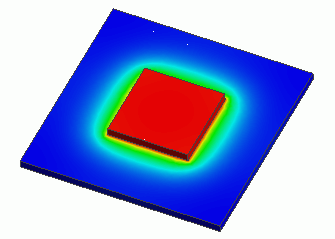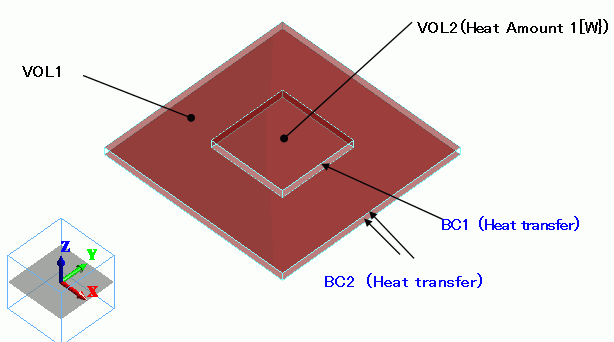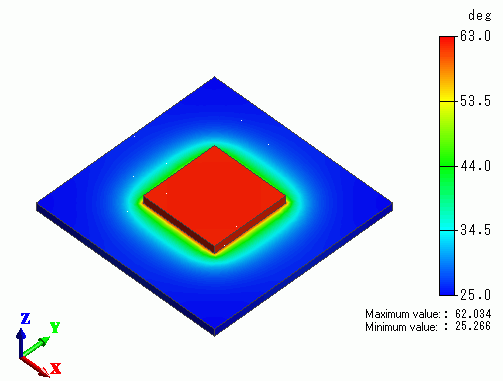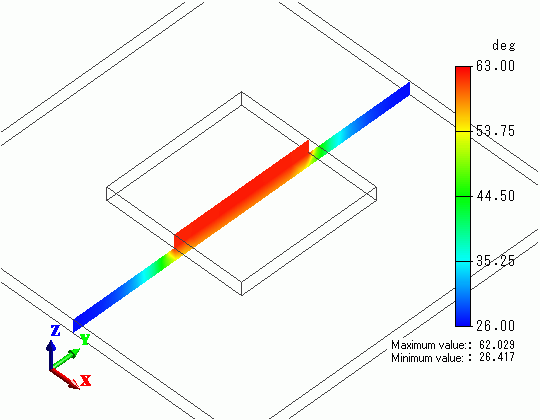
CAE Software【Femtet】Murata Software Co., Ltd.

Example7 Heat Radiation by Forced Convection(Steady-State Analysis)

General
-
A heat source is placed on a substrate, and there is a forced air flow for cooling in parallel to the substrate. The heat radiation is analyzed under the steady-state condition.
-
The heat transfer coefficient is acquired manually.
To acquire it automatically, see “Ex.1 of Simple Fluid-Thermal Analysis”.
-
The temperature distribution and the heat flux vectors are solved.
-
Unless specified in the list below, the default conditions will be applied.
Analysis Space
|
Item |
Settings |
|
Analysis Space |
3D |
|
Model unit |
mm |
Analysis Conditions
|
Item |
Settings |
|
Solver |
Thermal Analysis [Watt] |
|
Analysis Type |
Steady-state analysis |
|
Options |
N/A |
Model
The substrate (VOL1) and the heat source (VOL2) are created as solid body box, and the heat amount is defined in the body attribute of VOL2.
The heat transfer coefficients for the top and bottom faces of the substrate and the top face of the heat source are calculated by the simplified equation.

Body Attributes and Materials
|
Body Number/Type |
Body Attribute Name |
Material Name |
|
0/Solid |
VOL1 |
006_Glass_epoxy * |
|
1/Solid |
VOL2 |
001_Alumina * |
* Available from the Material DB
The heat source of VOL2 is set up as follows.
|
Body Attribute Name |
Tab |
Settings |
|
VOL2 |
Heat Source |
1[W} |
Boundary Conditions
The heat transfer coefficients for the forced convection are calculated as follows. For the details, please refer to the Heat Transfer Coefficient for Forced Convection
To acquire it automatically, see “Ex.1 of Simple Fluid-Thermal Analysis”.
h = 3.86 x (V/L)0.5xC [W/m2/deg]
where
Air flow V=1[m/s]
On the top and bottom faces of VOL1: Characteristic length L=0.05, C=1 -> h=17.26
Top face of the heat source (VOL2): Characteristic length L=0.02, L’=0.015, C=1 * -> h=27.3
*
The thickness (d) of the speed boundary layer at the edges of the heat source is calculated as follows
d=0.0182x(L’/V)0.5= 2.3[mm]
This is close enough to the thickness of heat source, so we set C=1.
|
Boundary Condition Name/Topology |
Tab |
Boundary Condition Type |
Settings |
|
BC1/Face |
Thermal |
Heat Transfer/Ambient Radiation |
Heat transfer coefficient: 27.3 [W/m2/deg] Ambient temperature: 25[deg] |
|
BC2/Face |
Thermal |
Heat Transfer/Ambient Radiation |
Heat transfer coefficient: 17.26 [W/m2/deg] Ambient temperature: 25[deg] |
Results
The temperature distribution is shown below.

A section’s temperature distribution is shown below.


